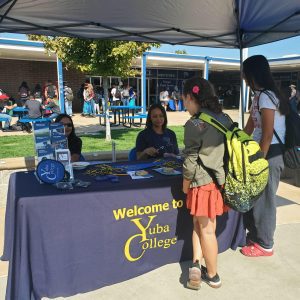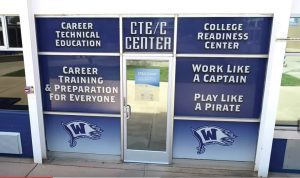 Part 1: There are career boosts, and then there are career blastoffs.
Part 1: There are career boosts, and then there are career blastoffs.
Like the Wheatland Union high schooler who took off with not one but two associate degrees a week before graduation — now two years closer to a college degree and becoming a much-needed California educator. Or the young learner who earned a certified nursing assistant license, skyrocketing her straight from a high school diploma to a high-demand career.
These are just a few of the Strong Workforce success stories happening every day in the region’s K-14 career technical education pathways.
“We’ll have students this year that will graduate with patient care technician licenses, where they could work in a dialysis center for $40 an hour right out of high school,” says Carol Keiser, Director of CTE and College Readiness at Wheatland Union High School District. “That also gives them incredible work experience as they continue their education in nursing.”
In health, IT, agriculture, and beyond, there aren’t enough trained employees to fill positions. In fact, California’s projected workforce gap for middle-skill workers may be as high as 1.5 million by 2025, according to the Public Policy Institute of California.
That’s why leaders across the state created the Strong Workforce Program in 2016 to help fund vital CTE programs. SWP helps build a strong pipeline from K-12 to community college and employment, giving students a healthy workforce head start.
“These are jobs that require higher education and certifications, but not necessarily a bachelor’s degree,” says Tanya Meyer, SWP K-14 Technical Assistance Provider at the North Far North Regional Consortium. “These jobs are just sitting there with livable wages, and they are jobs that are in high demand.”
While employers struggled to fill positions, students who wanted to launch into careers had fewer options — until the Strong Workforce Program took regional CTE to the next level.
“Strong Workforce beefs up our CTE programs to push students into jobs with livable wages that don’t necessarily require a bachelor’s degree,” says Meyer. It’s a program that’s good for students and good for the economy. “If we can get students trained for these in-demand job openings, then it’s a win-win — and we’ve increased our state revenue because our tax base is higher when unemployment levels are low.”
Take Wheatland Union High School District, where Superintendent Nicole Newman recently received the Golden Bell Award from the California School Boards Association for the “Pirates at SEA” (Scholar Enrichment Academies) program. Pirates at SEA set sail in 2020 with the help of Strong Workforce, offering career readiness and exploration while strengthening the dual enrollment pipeline with nearby Yuba College. The class of 2024 has 250 students enrolled in CTE career pathways, increasing graduation rates, college enrollment, and career opportunities while reducing student debt.
“We’ve been able to start three new pathways a year,” says Keiser. “We’re very intentional in helping students identify what they want to pursue, creating programs, looking at our labor market demands, and feeding into the Yuba College pathways. … The enrollment at Yuba College of Wheatland students has greatly increased.”
For example, Wheatland offers an animal science pathway that articulates directly with Yuba College, so high school students can complete the college’s veterinary technology prerequisites for early career advancement. The school also developed an in-demand patient care pathway, with a capstone course where students can earn licenses to become certified nursing assistants and patient care technicians.
“There is no way we would have been able to do the extent of our model had we not had Strong Workforce funding,” says Newman. “We want to give students as many opportunities as we can.”
In fact, the hallmark of the Strong Workforce Program is increasing collaboration across the K-12 and community college systems with input from employer partners, aligning curriculum to industry needs. Stackable certificates, degrees, and internship and apprenticeship opportunities lead students directly to high-demand, high-paying careers, strengthening the local talent pipeline and beyond.
“We’re building the economy of the state, and we’re building the economy of the region,” says Meyer. 
Another major component of the Strong Workforce Program is giving historically underrepresented students economic advancement opportunities, with built-in accountability to make sure learners of all backgrounds succeed.
“We’re targeting equity in our CTE programs to ensure we are not leaving students behind,” says Meyer. She recently conducted two equity training programs for the region to help schools find and address any gaps in student demographics, supporting access and inclusion in the region’s employment-boosting programs. Part of that effort is verifying that students complete programs to get trained and certified for their industry.
“Equity, economy, and completion are like a three-legged stool of SWP,” says Meyer. “This approach aligns with the regional consortium’s goals to provide access to high-quality, post-secondary educational programs for immediate employment.”
The SWP grant is highly competitive, and each year, the regional selection committee decides the awards. Industry partners, nonprofit leaders, and K-14 teachers and administrators collaborate. Meyer says, “Decisions are made by this group from the region that are looking at what’s best for the region’s students and economy.”
Wheatland’s superintendent has been on the SWP selection committee for four years and says it is a labor of love.
“CTE and vocational education has always been my passion,” says Newman. “Being able to sit in a room of educators, support awarding this money, and see it go into good programs that support our students in Northern California makes my heart happy.”
Each Strong Workforce application is reviewed by three readers, always including at least one educator and industry partner who don’t have any conflicts of interest. “It’s a very confidential process,” explains Newman. “We have conversations about whether it is a viable pathway that really meets the labor market needs to ensure they are preparing students for gainful employment.”
Newman says if schools want to apply for SWP funding, they should take full advantage of the generous support the North Far North Regional Consortium offers.
“Tanya does great webinars,” says Newman. “She’s very easy to talk to, and she is going to answer your questions.
“It’s up to us as school districts, directors, and grant writers to ensure we take advantage of that. … Those training sessions are definitely going to help you move forward.”
Learn more about the unparalleled support SWP grant recipients are given in the North Far North in our next article, “Closing the Workforce Gap Collaboratively: How Strategic SWP Support Catalyzes Regional CTE.”
December 2023